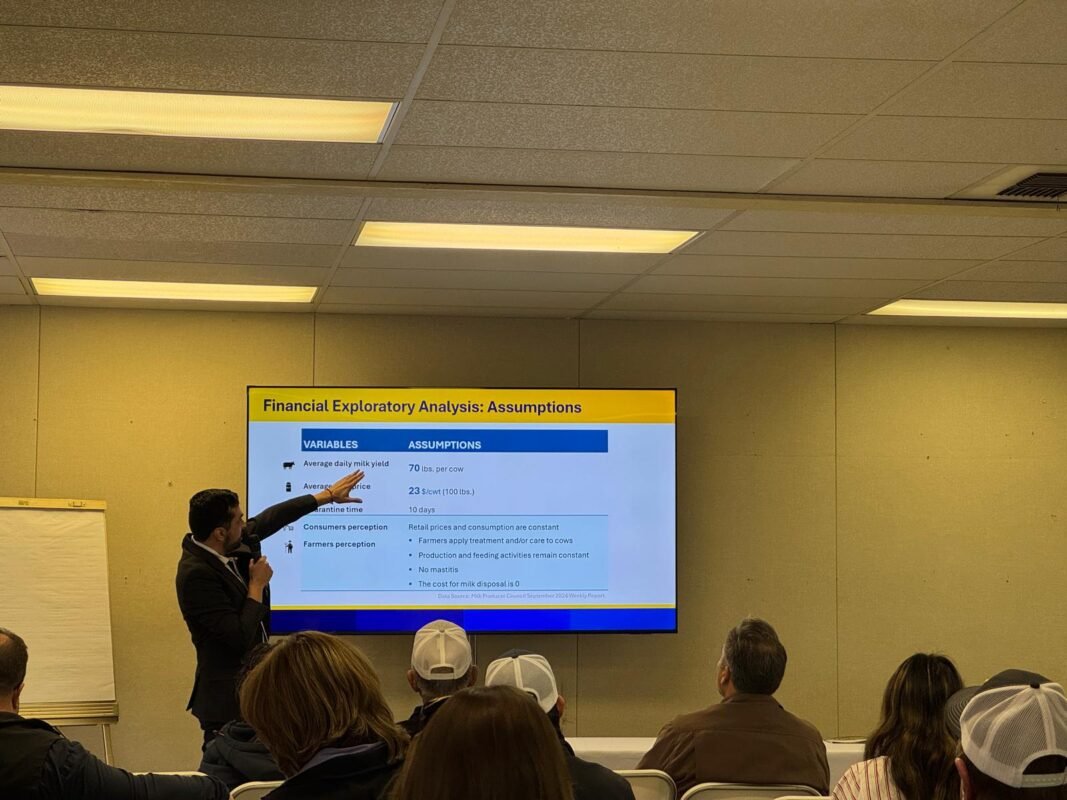Louis Lab at UC Davis at the World Ag Expo 2025
Feb 17, 2025
Luis Garcia-Covarrubias, PhD | Tulare, California

On February 12, the Louis Lab at UC Davis participated in the 2025 World Ag Expo in Tulare [1]. We engaged with stakeholders, experts from diverse disciplines, and the general public, sharing insights and discussing some of today’s most pressing dairy economics challenges.
Presentations
Navigating Labor Challenges and Automation in California and Wisconsin Dairy Farms
This session, presented by our lead researcher, Assistant Professor Dr. Luis Peña-Lévano, explored how Automatic Milking Systems (AMS) offer a promising solution to reducing labor reliance on dairy farms. However, AMS adoption remains challenging due to its significant upfront investment costs.

«AMS may reduce the reliance on labor, which is a significant cost for dairy farms in major dairy states, trading off a variable cost with a fixed cost (e.g., investment).»

The study also examined the labor structures of dairy operations in California and Wisconsin, evaluating the practical benefits, financial challenges, and farmer perspectives on integrating automation into farm management.
Avian Flu Impacts on the U.S. Dairy Industry
Delivered by postdoctoral scholar Dr. Luis F. Garcia-Covarrubias, this seminar addressed the impact of avian flu on dairy herds across the U.S., with California experiencing the highest number of recorded cases.
Key discussion points included milk production disruptions, rising costs for farmers due to outbreaks, and trade restrictions.
While avian flu has a 90% mortality rate in chickens, it only has an average 2% mortality rate in cows. However, infected cows still need to be quarantined, significantly reducing milk production. Our exploratory financial analysis estimated that each infected cow costs farmers approximately $198, aligning with the $100–$200 range calculated by the American Association of Bovine Practitioners [2]. Given the economic burden on large-scale farms, prevention remains essential. We encourage farmers to continue testing and implementing biosecurity measures while further research unfolds.
Sustainable Production in Dairy Farms
This session, led by Research Fellow Dr. Karl-Friedrick Boy, examined the growing environmental challenges faced by dairy farms and the increasing influence of consumer preferences on sustainability
We discussed how sustainable practices can help dairy farms reduce their carbon footprint and explored the key factors shaping sustainability adoption, including geographic location, climate perceptions, farmer demographics, and climate-smart technologies and practices
Engagement & Acknowledgments
Each session featured an engaged and thoughtful audience, including students, stakeholders, dairy industry experts, policymakers, and members of the public. Their insightful questions and discussions enriched the conversations, and we are deeply grateful for their participation. We look forward to continuing these important discussions in future events!
A special thank you to our co-authors and collaborators for their contributions to this research:
– Dr. Allan F. Pinto, Research Scientist in Agricultural Economics at Cornell University
– Dr. Shaheer Burney, Associate Professor of Agricultural Business and Director of the Survey Research Center at the University of Wisconsin-Madison.
– Dr. Richard Van Fleck Pereyra, Associate Professor of Clinical Livestock Herd Health at UC Davis


References
[1] World Ag Expo. (2025). World Ag Expo 2025. International Agri-Center. Retrieved February 14, 2025, from https://www.worldagexpo.com/
[2] Hossain, M. A., Monem, M. A., & Rina, A. A. (2024). The growing risk of avian influenza (H5N1) in dairy cows: Clinical, economic, and public health consequences. New Microbes and New Infections, 62, 101531. https://doi.org/10.1016/j.nmni.2024.101531


